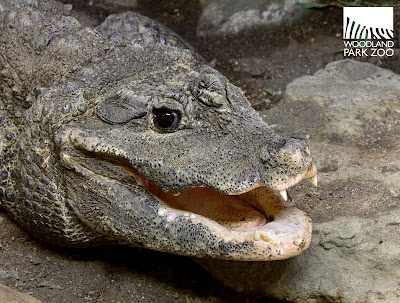Posted by: Kirsten Pisto, Communications
Unless you’ve been on a tropical getaway for the past month, you probably noticed that the Pacific Northwest welcomed in the coming winter season with regular drenchings of heavy rain. This is the time of year when leaves clog drainpipes, and puddles emerge on the streets, sometimes as big as ponds. Well, if you were a West African dwarf crocodile you would be very pleased!
 |
Woodland Park Zoo’s male dwarf crocodile almost fully submerged on exhibit. Photo by Alex Monopolis.
|
Dwarf crocodiles (
Osteolaemus tetraspis) are a special type of small crocodile species found in the tropical rivers and swamps of sub-Saharan West Africa and West Central Africa. They thrive in swamps and rainforest rivers, but have also been found in Savannah flood zones where they soak up the extra moisture during the wet season, and dig burrows in heavy mud to aestivate during the subsequent dry season.
 |
Dwarf crocodile camouflaged on exhibit at Woodland Park Zoo’s Day Exhibit. Photo by Kirsten Pisto/Woodland Park Zoo.
|
The dwarf crocodile is itself divided into two subspecies: The Congo dwarf crocodile (
Osteolaemus tetraspis osborni) and the West African dwarf crocodile (
Osteolaemus tetraspis tetraspis). Our West African dwarf crocodiles have a knob on their snouts which distinguish them from their Congolese cousins.
Woodland Park Zoo houses two beautiful West African dwarf crocodiles—a pair, male and female. Staying true to their timid behavior, our dwarf crocs have not revealed their names to us. In fact, their toothy grins seem to be hiding more than a few secrets. Did you know that a crocodile can go through about 3,000 teeth in its lifetime? Crocs use their chompers to catch and bite their prey, so they can’t afford to have any toothy mishaps. Instead of simply falling out, each tooth is hollow, and allows a new tooth to grow inside the older tooth. This way, when one tooth gets pulled out, there is a brand new tooth ready to go where the old one was lost. And that famous crocodile smile? It’s due to the fact that most of their teeth sit outside their mouth.
 |
Woodland Park Zoo’s female dwarf crocodile shows her teeth. Photo by Dennis Dow/Woodland Park Zoo.
|
Most of the time, our crocs take it easy. These ancient creatures rest most of the day, but their senses are always on cue. One really cool thing about crocodiles is their sensory organs. Both upper and lower jaws are covered with sensory pits, which appear as tiny, black speckles on the skin. These pigmented nodules hold bundles of nerve fibers that respond to the slightest disturbance in surface water, detecting vibrations and small pressure changes in water. These organs are known as
dermal pressure receptors. While alligators and caimans only have them on their jaws, crocodiles have similar organs on almost every scale on their body! These organs make it possible for crocodiles to snap at prey, catch dinner, sense mates, and dodge dangers such as predators and other crocs even in total darkness.
 |
Close up of male dwarf crocodile. Photo by Dennis Dow/Woodland Park Zoo.
|
So, since our crocodiles won’t disclose their names, and both share toothy smiles and croc like reflexes, how do we tell them apart? Easy. Our female is pretty tiny and weighs only 40 pounds, compared to her mate who weighs 175 pounds! Typically, female dwarf crocodiles are about 3-4 feet long and males are usually 4-5 feet long, but our male is an exception at 6.3 feet! Because of their sizable difference; the two can easily be identified.
 |
The male dwarf crocodile, seen here, is considerably larger than the female on exhibit. Photo by Kirsten Pisto/Woodland Park Zoo.
|
Our crocodiles have produced 14 babies since they came to Woodland Park Zoo as young adults in 1973. Surviving offspring have been sent to zoos as far away as South Africa. In the wild, West African dwarf crocodiles eat mainly fish, but also frogs, birds and small mammals. Here at the zoo, our crocs are fed mice, rats, chicks and quail for variety, but their favorite snack is… all of the above!
 |
A dwarf crocodile tail. Photo by Ryan Hawk/Woodland Park Zoo.
|
Keeper Peter Miller lets us in on something really cool to look out for when visiting our dwarf crocs—the male vocalizing to the female. The male lets out a really low growl, typically with his throat submerged in the water. This causes the water to vibrate vigorously, and water droplets begin to dance on the surface.
Like most of the 23 species of crocodiles, both dwarf crocodile subspecies are endangered due to overhunting, persecution and habitat deconstruction.
Learn more about these incredible reptiles and how you can help protect them.
 |
Dwarf crocodile in water. Photo by Mat Hayward/Woodland Park Zoo.
|
Our dwarf crocs can be seen in the Day Exhibit, along with the majority of our reptiles and amphibians. The best time to visit them is early morning or late afternoon, and especially on Sundays, which is feeding day!
The next time your rain gauge overflows and the puddles begin to take over the streets, head over to our
Day Exhibit (where it is always nice and warm!) and say hello to our resident crocs. They will be waiting for you!







Comments
Crocodilians only get so many replacement teeth in their lifetime. They get dozens of replacements for every tooth in comparison with only two that humans get. We think that our male croc has run out of teeth in his lower jaw. He is 43, well beyond middle-aged for his species.
Thank you!
Very cool to read more about your crocs! I've spent several rainy days this winter drawing the big male ( http://bit.ly/x8pYXj ) and have wondered about some of the stuff you explain here. Thanks!
Post a Comment